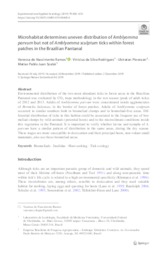Microhabitat determines uneven distribution of Amblyomma parvum but not of Amblyomma sculptum ticks within forest patches in the Brazilian Pantanal.
Microhabitat determines uneven distribution of Amblyomma parvum but not of Amblyomma sculptum ticks within forest patches in the Brazilian Pantanal.
Author(s): RAMOS, V. do N.; RODRIGUES, V. da S.; PIOVEZAN, U.; SZABO, M. P. J.
Summary: Environmental distribution of the two most abundant ticks in forest areas in the Brazilian Pantanal was evaluated by CO2 traps methodology in the wet season (peak of adult ticks) of 2012 and 2013. Adults of Amblyomma parvum were concentrated inside agglomerates of Bromelia balansae, in the border of forest patches. Adults of Amblyomma sculptumoccurred in similar numbers both in bromeliad clumps and in bromeliad-free areas. Dif-ferential distribution of ticks in this habitat could be associated to the frequent use of bro-meliad clumps by wild animals (potential hosts) and to the microclimate conditions inside this vegetation in the Pantanal. It is important to verify whether larvae and nymphs of A. parvum have a similar pattern of distribution in the same areas, during the dry season. These stages are more susceptible to desiccation and their principal hosts, non-volant small mammals, also use these bromeliad areas.
Publication year: 2019
Types of publication: Journal article
Keywords: Bromélia, Carrapato, Fauna Parasitaria, Pantanal
Observation
Some of Embrapa's publications are published as ePub files. To read them, use or download one of the following free software options to your computer or mobile device. Android: Google Play Books; IOS: iBooks; Windows and Linux: Calibre.
Access other publications
Access the Agricultural Research Database (BDPA) to consult Embrapa's full library collection and records.
Visit Embrapa Bookstore to purchase books and other publications sold by Embrapa.

